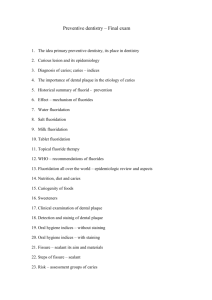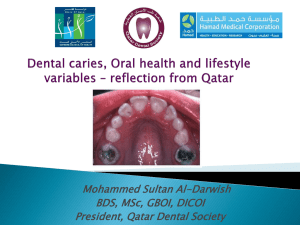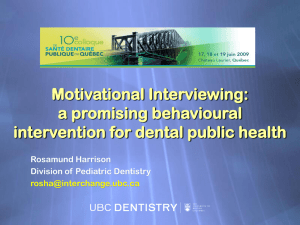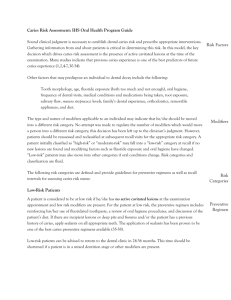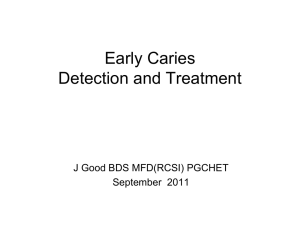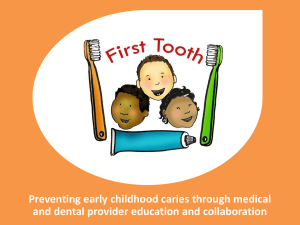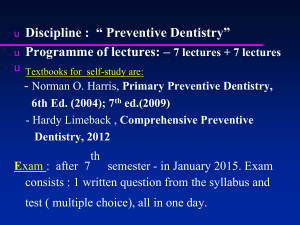OH Training Module 3 - Oral Screening Exam
advertisement
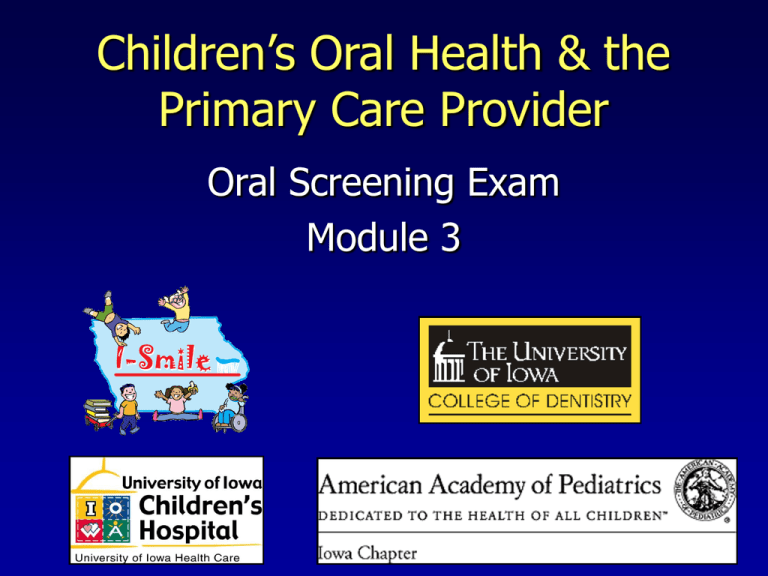
Children’s Oral Health & the Primary Care Provider Oral Screening Exam Module 3 Module 3 Objectives: Learn to perform a knee-to-knee oral screening exam for infants & toddlers Learn helpful tips to gain access to a child’s mouth & restrain a child’s body movements during an oral screening exam Learn to identify clinical findings predictive of high caries risk for infants & toddlers Learn to identify caries in its different stages (non-cavitated (white spots) vs. cavitated lesions) Knee-to-Knee Oral Screening Exam Step 1: Child is held facing caregiver in a straddle position Step 2: Child leans back onto examiner while caregiver holds child’s hands and legs Step 3: Provider performs exam while caregiver effectively restrains child’s hands and legs Equipment for the Oral Screening Exam Disposable gloves Good light source Disposable mirror (optional) Toothbrush or gauze (for plaque removal) Performing an Oral Screening Exam Place the child in the knee-to-knee position Restrain child’s head and body movements Lift the child’s upper lip and lower child’s lower lip Lift-the-Lip Procedure Knee-to-Knee Position: Dental Setting Double-click the picture to begin the video clip Knee-to-Knee Position: Medical Setting Double-click the picture to begin the video clip What Clinical Findings Are Predictive of High Caries Risk? Previous Caries Experience One of best predictors of future caries For children under age 5, a history of decay should automatically classify a child as high risk Not useful caries-risk predictor for infants and toddlers (insufficient time for ECC to be expressed) Visible Plaque One of the best predictors of future caries risk in young children Screening for visible plaque is easy and inexpensive Dental Plaque Dental Plaque White Spot Lesions Also referred to as non-cavitated lesions Initial stage (precursor) of the caries process Equivalent to caries for infants and toddlers Chalky, white spots on primary teeth are demineralized areas and are considered early decay White Spot Lesions Are often: Observed next to the gum line Accompanied by plaque Accompanied by bleeding gums (gingivitis) Chalky, white spots on primary teeth are demineralized areas and are considered early decay Figure 1 From White Spots to Frank Caries Figure 2 Figure 3 Yellow arrows show white spot lesions (non-cavitated) close to the gum line Green arrow and circle show an area where the enamel is starting to break down and a frank cavity (cavitated lesion) is starting to develop Yellow arrows show white spot lesions (non-cavitated lesions) Green arrow show frank cavities (cavitated lesions) All pictures show advanced frank cavities (cavitated lesions) that have reached the nerve (pulp) of the teeth. These children are in pain and need immediate and/or emergency dental treatment Green arrow shows the presence of an abscess due to a necrotic tooth Enamel Defects & Stained Pits and Fissures Enamel hypoplasia Stained pit and fissure surfaces of primary teeth Consider these indicative of increased caries risk Enamel Hypoplasia Stained Pits and Fissures Presence of Braces and Oral Appliances Caries Risk Assessment and Management Any observable decay or demineralization (white spots): - Refer for dental care as soon as possible Any factors on the oral screen (or parent interview) that increase the child’s risk for caries: - Refer for dental care Uncertain caries risk: - Refer for dental care Refer to your I-Smile Coordinator for care, assistance with referrals & to ensure dental care is established Re-assess to ensure the child has been evaluated by a dentist & has established regular dental care I-Smile Coordinators I-Smile coordinators are dental hygienists who serve as prevention experts and liaisons between families, health care professionals, and dental offices to ensure completion of dental care. Coordinators are located in regional public health agencies and provide local community support throughout Iowa. I-Smile Coordinators can: • Assist with dental referrals for young children. • Provide Medicaid dental billing information. • Offer education for healthcare professionals regarding children’s oral health, including screening and fluoride varnish training. I-Smile Coordinator contact information can be found at: www.idph.state.ia.us/hpcdp/oral_health.asp or I-Smile hotline 1-866-528-4020 Summary: Oral Screening Exam Use the knee-to-knee position for oral screening exams Clinical findings predictive of high caries risk for infants and toddlers: previous caries experience visible plaque white spot lesions enamel defects stained pits and fissures oral appliances Summary: Oral Screening Exam During an oral screening exam remember to: Restrain the child’s head and body movements “Lift-the-lip”: lift the upper lip & pull down the lower lip to examine the child’s teeth Dry the child’s teeth to examine for white spot lesions Remove plaque using a toothbrush or gauze to examine for possible white spot lesions under plaque Summary: Oral Screening Exam Refer a child for dental care as soon as possible if any caries or white spot lesions are observed Refer for dental care if any of the clinical findings predictive of high caries risk are observed and/or if you are uncertain of the child’s caries risk Refer to your I-Smile Coordinator for care & to ensure dental care is established
